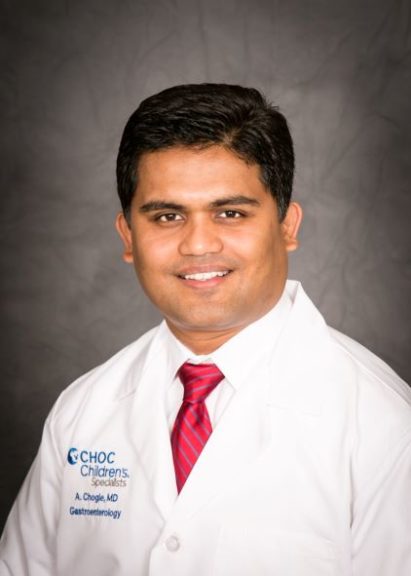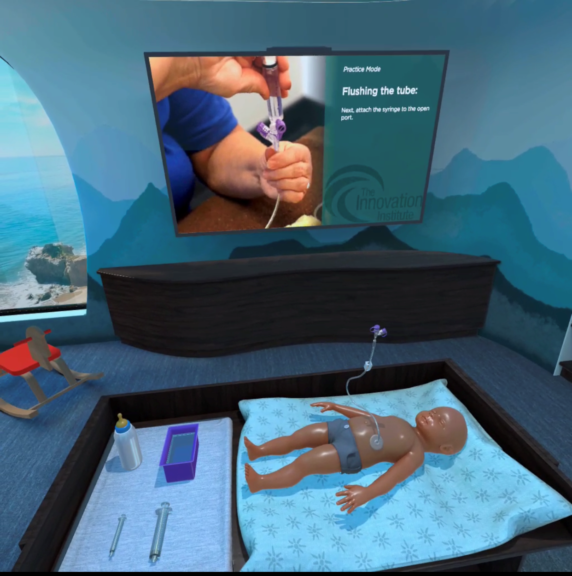Two CHOC associates have spent the past year developing an app to help parents caring at home for kids with medical devices such as gastric tubes, tracheostomy tubes, PICC lines, and central venous catheters.
The app, CareXR, will immerse parents in a virtual reality world created by pediatric gastroenterologist Dr. Ashish Chogle in partnership with veteran nurse Wanda Rodriguez, an instructor in the CHOC HELPs program.

The two gave a short demo on the new app during Pediatric Innovation Start-up Demo Day, an online forum hosted by The Innovation Lab in Newport Beach on May 20, and will present the app again at CHOC Innovation Day on June 25.
Dr. Chogle designed the app in collaboration with Wanda, The Innovation Lab — which CHOC is affiliated with — and BioflightVR, a virtual reality app development company based in Santa Monica.
The CareXR platform will feature practice modules intended to provide parents and caregivers peace of mind when caring for kids at home. Forty-two percent of children are discharged from U.S. hospitals with some medical technology, the majority being G tubes and central lines.
CareXR is the first app developed by Dr. Chogle, whose philosophy includes pushing the envelope. His email signature reads, “No one made a difference by being like everyone else.”
“That’s my life philosophy,” Dr. Chogle says. “I follow it. I’m a physician and I like taking care of my patients, but I always try to go beyond that. I’m always trying to do something extra for my patients.”
Details about what the immersive world of the CareXR will look like, and what equipment parents will need to experience it, will be previewed at CHOC Innovation Day — “A Celebration of Innovation at CHOC” — on Friday, June 25, from 1-3 p.m. The online session, held in honor of the late Dr. Nick Anas for his contributions to innovation and medical intelligence, is open to all CHOC physicians and associates.
The virtual event will feature remarks by CHOC CEO Kim Cripe and Dr. Anthony Chang and also will showcase chief technology officer Adam Gold’s uTine autism app, groundbreaking artificial intelligence projects, innovation by nurses and much more.
“I’m very excited,” says Wanda, who will celebrate 43 years as a CHOC medical surgical nurse this July. “My biggest excitement is for the families. They’ll be able to see what they were taught here before their child was discharged and watch it as many times as they want, and wherever they want — on their smart phones or computer.”
Wanda conducts the virtual reality teaching sessions. The first module will detail PEG tube care (Percutaneous Endoscopic Gastrostomy tube). PEG tubes allow patients to receive nutrition through their stomachs.

CHOC already sends parents home with reading materials followed by a one-hour, in-person class Wanda teaches to make them feel comfortable in caring for the device. The new app takes this instruction to an entire new level, says Wanda and Dr. Chogle, both of whom believe this is the first such app developed at any pediatric hospital.
“I feel like God gave me this project,” says Wanda, who became involved in it after hearing the concept that was pitched by Dr. Chogle at a pediatric “Hack-A-Thon” hosted by CHOC in February 2020. A hack-a-thon is a session where a group comes together to create software to accomplish a set goal.
“When I found out about the concept, I was just totally thrilled,” Wanda says. “And what BioflightVR and The Innovation Lab have come up with is amazing.”
The first module in the app is expected to be completed this June, Dr. Chogle says.
The “XR” in the app’s name stands for extended reality.
“My concept is we’re extending the care for patients in terms of quality as well as location – we’re extending the care into their home,” Dr. Chogle says. “We’re going to keep adding modules so parents can pick and choose depending on what condition and device their child has.”
Dr. Chogle, whose favorite TV show is, not surprisingly, “Shark Tank,” where inventors pitch projects to potential investors, plans to research the efficacy of the app at CHOC and other partner sites.
“I love the concept of coming up with new ideas to change the status quo,” explains Dr. Chogle, who has been at CHOC for six years.
Wanda says the virtual reality program will be light years beyond the typically dry medical device videos now available. The immersive experience of the first module of CareXR will cover such topics such as site care, feeding, and more.
“I think CHOC is the first hospital out of the gate on this,” she says. “And everyone will be able to see it after May 20.”
Dr. Chogle says he became interested in the use of virtual reality in healthcare after seeing a presentation by another gastroenterologist, Dr. Brennan Spiegel at Cedars-Sinai. Dr. Spiegel uses virtual reality for pain management in adults.
“I started following Dr. Spiegel’s work,” Dr. Chogle says. His first foray into the virtual reality universe involved using biofeedback applications to treat patients with IBS (irritable bowel syndrome).
Dr. Chogle recalls a CHOC patient’s family distress at having to care for their child with a G-tube.
He recalls the flustered father telling him at a follow-up visit to his clinic: “I wish we were back in the ICU so the nurses could take care of our child. There’s this foreign thing sticking out of my kid’s belly and I’m afraid to touch it.”
Recalls Dr. Chogle: “That’s when it struck me: Is there any way, I thought, to teach these parents in a better way where they can focus on what is being taught, then repeat if needed what is being taught, and they practice the tasks which they were taught without having to actually handle the tube on their child? I thought, ‘What if I use virtual reality technology to better educate these parents and let them practice in a virtual world so they become comfortable with it?’ Also, there’s always the question of when we discharge a patient. Sometimes the parents push back, saying, ‘Oh, no, we’re not comfortable leaving yet.’ What if we are able to determine the readiness of the parents to be discharged?”
There are four parts to the teaching app. The first is an animated video of exactly what is going to happen during the surgical procedure to implant the device. The module then teaches parents about the different parts of the device, how to hook it up, how to take care of it, and how to identify complications to seek help. The third section is interactive where parents can practice the task in virtual reality. The fourth section tests the parents on their newly acquired skills and lets the bedside team determine if the parents are ready to go home with the device.
“Basically,” says Dr. Chogle, “this is about optimal teaching, reinforcing that teaching, and building the confidence of parents and caretakers.”




